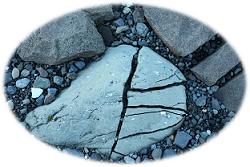Jesus and Creation: Jesus’ Death and Creation
Jesus and Creation: Jesus’ Death and Creation
In the previous article we spoke about Jesus’ suffering and creation. Now we give special attention to His dying. Here too we notice that the gospel account mentions some very special events that took place when Jesus voluntarily gave up His life.
When Jesus breathed his last, His death was a conscious act. At that same moment something very special happened in the temple. Spontaneously, the curtain of the temple tore, from top to bottom. This tells us that the temple was under God’s judgment and that God Himself declared this house uninhabitable. He leaves the sanctuary and gives it up to destruction. There is here a serious message about the termination of the worship service of that time. At the same time there is the announcement that, because of the Saviour’s death, there is freedom of access to God (cf. for example Hebrews 10:19 and 20).
The earth trembles⤒🔗
Matthew 27:51 mentions as second sign that the earth trembled. In the Old Testament an earthquake is often a sign that accompanies God’s appearance in glory and light. At the death of the Saviour it is a divine sign of the uniqueness of Jesus’ death. A change takes place not only in divine worship and in God’s dwelling among His people; the entire cosmos is involved. Everything shows that in this death we meet with a decisive turning point in the history of the universe. The significance of Jesus’ suffering and death on the cross is much greater than we assume. Jesus’ dying is so shocking that the event affects all of created reality. “The dying of Jesus has a wide, even cosmic significance” writes J. P. Versteeg.
Signs are therefore seen everywhere, showing the greatness of this Saviour of the world. At the same time they form a judgment for all those who attack Him and a terror for His enemies. They have crucified the Lord of glory.
Tombs opening←⤒🔗
Matthew 27:52 mentions yet a third startling happening at the time of Jesus’ death. Herein sounds a divine testimony. At this time already God proclaims that death does not have the last word. Jesus’ victory over death is certain. The shock of this dying is felt within the realm of death. There especially the glorious and divine power of His death penetrates. We have a sign or portent here of the last day. In principle the final victory has been won. Bodies of departed saints are raised. Deceased, God-fearing, righteous people come temporarily back from death. The precise time of this revival is not made fully clear to us. Does this resurrection immediately follow the death of the Saviour, or does verse 53 want to make it clear to us that this happened after Jesus’ resurrection? However this may be, it appears that the raised saints appear too many in Jerusalem only after the Lord’s resurrection. Apparently we have to notice that with the Savour’s death preparations are made for these departed saints for their resurrection, which then happens after the Lord has been raised from the death.
This glorious testimony of Scripture has not been given to us in order to indulge in phantasies, nor is it meant to satisfy our curiosity. It is a divine announcement of the enormous significance of the dying and resurrection of our Lord and Saviour. He did not die not for Himself, and He did not rise again for Himself. Everything here witnesses to the fruit for the church. The fact that in this connection bodies are specifically mentioned must stimulate us not to stress only the spiritual side of redemption. Through His Son, God redeems people, body and soul, with their entire existence. Again we hear the themes of Genesis. Human beings are formed very carefully by God himself. Fallen humanity has prepared itself for corruption, for the return to the earth. But God’s work continues, unexpectedly! When the Son willingly gives His life He ensures the resurrection of the church He has bought. We see that God does not abandon His creation. At this dying we see that the surrender of the Lord’s body to death may never be explained as a devaluation of created reality. The Lord’s body is, in fact, in a miraculous way protected against decay. The bodily death of the Saviour is terrible and tarnishing. Specifically for Him, the pure man of God.
And yet there are also other factors to be kept in mind. For at the very moment of Jesus’ dying, preparations are becoming visible for a new life in biblical fullness. The body is not pushed aside as unimportant, but everything is made ready for the resurrection.
The nations come in view←⤒🔗
Matthew 27:54 tells of a very observant centurion and his soldiers. They are given an open eye for all the signs accompanying Jesus’ death: the earthquake, the splitting of the rocks,  the opening tombs. For them this is an announcement they cannot ignore. They see with fear the enormous trembling of nature. It overpowers them. There is more going on here than the dying of a ‘charlatan’ who thinks he is a king. They had mocked him. Now they see with dismay in all these signs the hand of God.
the opening tombs. For them this is an announcement they cannot ignore. They see with fear the enormous trembling of nature. It overpowers them. There is more going on here than the dying of a ‘charlatan’ who thinks he is a king. They had mocked him. Now they see with dismay in all these signs the hand of God.
We don’t know to what extent this affected them personally at that moment. But it is striking that what was the central charge against Jesus – His Sonship – is now being confessed by the mouth of pagans. This confession forms the fourth reaction upon the spectacular dying of Jesus. Herein we hear that the Saviour’s death has opened the way for the coming of salvation to the heathen world. And here it is precisely pagans who are more open to the work of God in the suffering and death of Christ than the Jews. We see how a prophecy made in Matthew 8:11 is in principle being fulfilled. The world of the nations enters the light of salvation.
Salvation reaches far←⤒🔗
The letter to the Colossians in particular shows how the Son is in a unique manner involved with creation and redemption. He is the image of the invisible God, the firstborn of all creation (Col. 1:15). All things were made by Him (Col. 1:16, 17). For that reason, His cross and resurrection have such great consequences for the wide reach of redemption. Col. 1:20 states that God was pleased “through him to reconcile all things, whether on earth or in heaven”. Sin broke the harmony between the creatures and their God. Sin ruined so much! Through the blood of the cross, sin has in principle been conquered (Eph. 2:11-18) and the requirement of the law fulfilled (Rom. 3:25, Gal. 3:13). The restoration of the harmony is true biblical peace. Here the core is the restored relationship with God, but it works through in other areas of life. Creation also comes to life again. Christ is now in glory, exalted at the right hand of the Father. From there He rules the universe with authority and power for the sake of the church and to the glory of the Father (note in this connection also Ephesians 1:10 and Philippians 2:10).
There is a distinction between the ways wherein different creatures subject themselves to Christ and are reconciled to God. Those who are and remain lost submit against their will. They just have to. They are defeated enemies (Colossians 2:15 and 1 Corinthians 15:24-28, and compare Ephesians 1:21, 22), without a real future. For those who follow God (angels and redeemed people),it is pure joy to bow down before this Lord and Saviour. Their heart is filled with him. Salvation reaches still farther. In Colossians we see the contours of God’s restored creation. Everything shows that God in His plan of salvation works toward restoration. That restoration has arrived in principle and it will be completed!
At present, we live as Christians still in an interim period, and that has consequences: we live “between times”. That is the life of Christian expectation, where the beckoning perspective of the new heaven and the new earth already determines our attitude. It will also put its stamp on our relationship with the earth. In spite of the still continuing brokenness, a Christian realizes his responsibility here and now, for the Son has given His life also for the redemption of creation. This reconciliation did not arise because of something that happened in another world, away from the earth, but has taken place in history and is therefore altogether real and almost palpable through the cross and resurrection. God’s salvation is always greater than we pray or think. It has enormous dimensions, of which we notice only a little yet, but it promises and guarantees very much!
This article was translated by Dr Freda Oosterhoff.

Add new comment